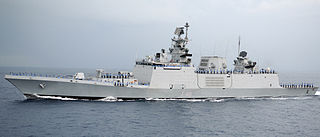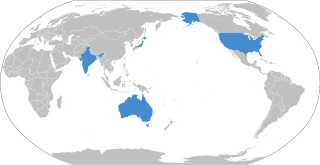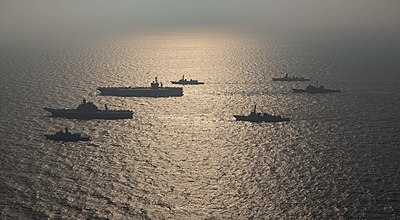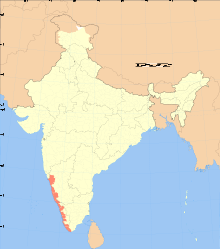
An aircraft carrier is a warship that serves as a seagoing airbase, equipped with a full-length flight deck and facilities for carrying, arming, deploying, and recovering aircraft. Typically, it is the capital ship of a fleet, as it allows a naval force to project air power worldwide without depending on local bases for staging aircraft operations. Carriers have evolved since their inception in the early twentieth century from wooden vessels used to deploy balloons to nuclear-powered warships that carry numerous fighters, strike aircraft, helicopters, and other types of aircraft. While heavier aircraft such as fixed-wing gunships and bombers have been launched from aircraft carriers, these aircraft have not landed on a carrier. By its diplomatic and tactical power, its mobility, its autonomy and the variety of its means, the aircraft carrier is often the centerpiece of modern combat fleets. Tactically or even strategically, it replaced the battleship in the role of flagship of a fleet. One of its great advantages is that, by sailing in international waters, it does not interfere with any territorial sovereignty and thus obviates the need for overflight authorizations from third-party countries, reduces the times and transit distances of aircraft and therefore significantly increases the time of availability on the combat zone.

The People's Liberation Army Navy, also known as People's Navy, Chinese Navy, or PLA Navy, is the maritime service branch of the People's Liberation Army, and the largest navy per number of ships in the world.

USS Kitty Hawk (CV-63), formerly CVA-63, was a United States Navy supercarrier. She was the second naval ship named after Kitty Hawk, North Carolina, the site of the Wright brothers' first powered airplane flight. Kitty Hawk was the first of the three Kitty Hawk-class aircraft carriers to be commissioned and the last to be decommissioned.

USS Ronald Reagan (CVN-76) is a Nimitz-class, nuclear-powered supercarrier in the service of the United States Navy. The ninth ship of her class, she is named in honor of Ronald W. Reagan, President of the United States from 1981 to 1989. She was built at Newport News Shipbuilding in Newport News, Virginia, and was commissioned on 12 July 2003.

USS Carl Vinson (CVN-70) is the United States Navy's third Nimitz-class supercarrier. She is named for Carl Vinson (1883-1981), a congressman from Georgia, in recognition of his contributions to the U.S. Navy. The ship was launched during Vinson's lifetime in 1980, undertook her maiden voyage in 1983, and underwent refueling and overhaul between 2005 and 2009.

The Russian navy is the naval arm of the Russian Armed Forces. It has existed in various forms since 1696; its present iteration was formed in January 1992 when it succeeded the Navy of the Commonwealth of Independent States.

The Indian Navy is the maritime branch of the Indian Armed Forces. The President of India is the Supreme Commander of the Indian Navy. The Chief of Naval Staff, a four-star admiral, commands the navy. As a blue-water navy, it operates significantly in the Persian Gulf Region, the Horn of Africa, the Strait of Malacca, and routinely conducts anti-piracy operations and partners with other navies in the region. It also conducts routine two to three month-long deployments in the South and East China seas as well as in the western Mediterranean sea simultaneously.
The Rim of the Pacific Exercise (RIMPAC) is the world's largest international maritime warfare exercise. RIMPAC is held biennially during June and July of even-numbered years from Honolulu, Hawaii, with the exception of 2020 where it was held in August. It is hosted and administered by the United States Navy's Indo-Pacific Command, headquartered at Pearl Harbor, in conjunction with the Marine Corps, the Coast Guard, and Hawaii National Guard forces under the control of the Governor of Hawaii.

USS Robert Smalls (CG-62) is a Ticonderoga-class guided-missile cruiser built during the Cold War for the United States Navy. Commissioned in 1989, the warship was originally named USS Chancellorsville for the American Civil War Battle of Chancellorsville. In March 2023, she was renamed for Robert Smalls, a former slave who freed himself and others by commandeering a Confederate transport ship.

USS Pasadena (SSN-752) is a Los Angeles-class submarine and the third ship of the United States Navy to be named for Pasadena, California.

The Shivalik class or Project 17 class is a class of multi-role frigates in service with the Indian Navy. They are the first warships designed with low observability features built in India. They were designed to have better stealth features and land-attack capabilities than the preceding Talwar-class frigates. A total of three ships were built between 2000 and 2010, and all three were in commission by 2012.

The Komandarm Fedko class is a class of replenishment tankers operated by the Indian and Chinese navies. Four ships of the Komandarm Fedko class were constructed by the Soviet Union, later Russia, of which one was bought by India, one by China and two are in commercial service. INS Jyoti is the third largest ship in the Indian Navy after the aircraft carrier INS Vikramaditya.
The Andaman and Nicobar Command (ANC) is a integrated tri-services command of the Indian Armed Forces, based at Port Blair in the Andaman and Nicobar Islands, a Union Territory of India. It was created in 2001 to safeguard India's strategic interests in Southeast Asia and the Strait of Malacca by increasing rapid deployment of military assets in the region. It provides logistical and administrative support to naval ships which are sent on deployment to East Asia and the Pacific Ocean.
The String of Pearls is a geopolitical hypothesis proposed by United States political researchers in 2004. The term refers to the network of Chinese military and commercial facilities and relationships along its sea lines of communication, which extend from the Chinese mainland to Port Sudan in the Horn of Africa. The sea lines run through several major maritime choke points such as the Strait of Mandeb, the Strait of Malacca, the Strait of Hormuz, and the Lombok Strait as well as other strategic maritime centres in Somalia and the littoral South Asian countries of Pakistan, Sri Lanka, Bangladesh, and the Maldives.

INS Kulish is a Kora-class corvette, currently in active service with the Indian Navy. She was ordered in October 1994 and the keel was laid in October 1995. The ship was launched in August 1997 and was commissioned on 20 August 2001.

The Quadrilateral Security Dialogue (QSD), commonly known as the Quad, is a strategic security dialogue between Australia, India, Japan and the United States that is maintained by talks between member countries. The dialogue was initiated in 2007 by Japanese Prime Minister Shinzo Abe, with the support of Australian Prime Minister John Howard, Indian Prime Minister Manmohan Singh and U.S. Vice President Dick Cheney. The dialogue was paralleled by joint military exercises of an unprecedented scale, titled Exercise Malabar. The diplomatic and military arrangement was widely viewed as a response to increased Chinese economic and military power.

INS Shakti (A57) is a Deepak-class fleet tanker in service with the Indian Navy. She was built by Fincantieri, an Italian shipbuilding company based in Trieste. She is the second and final ship of her class. Shakti, along with her predecessor Deepak, is one of the largest ships of the Indian Navy.

INS Jyoti (A58) is the third of four Komandarm Fedko-class replenishment oilers. She was modified for naval use and is now being operated by the Eastern Naval Command of the Indian Navy. Jyoti was the largest ship in the navy until INS Vikramaditya (R33) was commissioned in November 2013. Its primary role is fleet replenishment and sustaining blue-water operations. It was later fitted with close-in weapon systems for self-defence.

Milan is a multilateral naval exercise hosted by the Indian Navy. The biennial event features professional exercises and seminars, social events and sporting fixtures between participating nations.

































